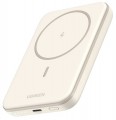Battery capacity
The higher the battery capacity, the more energy the power bank is able to accumulate and then transfer when charging to gadgets connected to it. But it should be borne in mind that not all of the accumulated energy goes specifically to charging – part of it is spent on service functions and inevitable losses in the process of transmission. So in the specifications, the real capacity of the power bank is also often specified. If there is no data on real capacity, then when calculating it is worth proceeding from the fact that it is usually somewhere 1.6 times lower than the nominal one. For example, for a model with a nominal capacity of 10,000 mAh, the actual value will be approximately 6300 mAh.
As for the specific values of the nominal capacity, then in models with the lowest performance it is
5000 – 7000 mAh and even
less ; such power banks are suitable as a backup source of energy for 1 – 2 smartphone charging with a not very capacious battery or other similar gadget. The
10,000 mAh solutions are the most popular nowadays – in many cases, this option provides the best price-capacity ratio. The
20,000 mAh and
30,000 mAh options are also very common. But even a capacity of
40,000 mAh or
more, thanks to the development of modern
...technology, is quite common.Real capacity
The real capacity of the power bank.
Real capacity is the amount of energy that a power bank is able to transfer to rechargeable gadgets. This amount is inevitably lower than the nominal capacity (see above) — most often by about 1.6 times (due to the fact that part of the energy goes to additional features and transmission losses). However, it is by real capacity that it is easiest to evaluate the actual capabilities of an external battery: for example, if this figure is 6500 mAh, this model is guaranteed to be enough for two full charges of a smartphone with a 3000 mAh battery and smartwatches for 250 mAh.
The capacity in this case is indicated for 5 V — the standard USB charging voltage. At the same time, the features of milliamp-hours as a unit of capacity are such that the actual amount of energy in the battery depends not only on the number of mAh, but also on the operating voltage. In fact, this means that when using fast charging technologies (see below) that involve increased voltage, the actual value of the actual capacity will differ from the claimed one (it will be lower). There are formulas and methods for calculating this value, they can be found in special sources.
Battery capacity
Battery capacity in watt-hour. These units of measurement are less popular than MilliAmp hour, but are more physically correct: they accurately describe the amount of energy accumulated by the battery. Thanks to this, in terms of capacity in Wh, it is possible to compare batteries with different rated voltages (while for mAh this is not allowed — additional calculations must be carried out using special formulas). At the same time, Wh can be converted to mAh without much difficulty if the battery voltage is known (for power banks this is in most cases 3.7 V): to do this, the capacity in Wh must be divided by the voltage and multiplied by 1000.
Power output (all ports)
The total charge power provided by the power bank on all connectors overnight - when devices are connected simultaneously to all charging ports.
This parameter is given due to the fact that the total charge power does not always correspond to the sum of the maximum powers of all available ports. The built-in battery of a power bank often has its own limitation on the output power. Therefore, for example, in a model with two 18 W USB ports, each total charge power can be the same 18 W. Note that the distribution of power among the connectors may be different: in some models it is divided equally, in others it is divided in proportion to the maximum current strength (if it differs on different ports). These nuances should be clarified using the detailed characteristics of the charging connectors.
If you plan to regularly use all power bank connectors at once, you should pay attention to this indicator.
Full charge time
The time required to fully charge a battery discharged “to zero”. Features of the charging process in different models may be different, respectively, and the time required for this may differ markedly even with the same capacity.
Fast-charging batteries tend to be more expensive. Therefore, choosing this option makes sense if you do not have much time to replenish your energy supply — for example, for hiking. However, keep in mind that charging at full speed may require a charger that supports certain fast charging technologies (see below).
It must also be said that in most modern batteries, the charging speed is uneven — it is highest at the several first percent from zero, then gradually decreases. Therefore, the time required to replenish the energy supply by a certain percentage will not be strictly proportional to the total claimed charge time; moreover, this time will depend on how much the battery is already charged at the time the procedure starts. For example, charging from 0 to 50% will take less time than from 50 to 100%, although both there and there we are talking about half the capacity.

